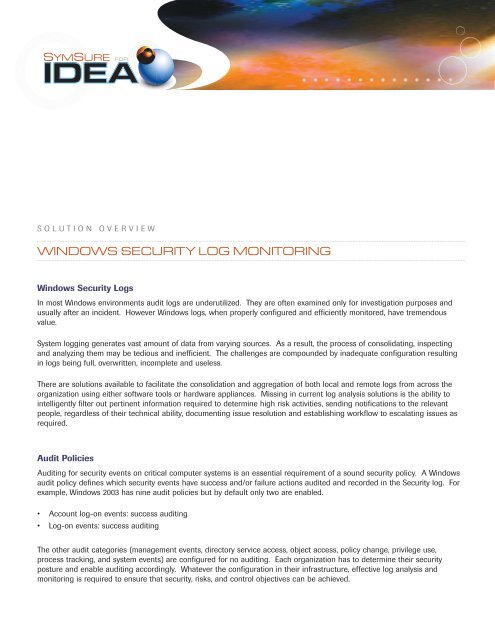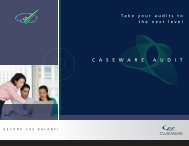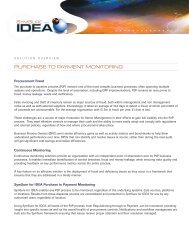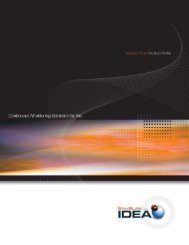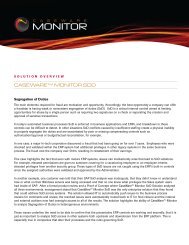windows security log monitoring - Caseware International Inc.
windows security log monitoring - Caseware International Inc.
windows security log monitoring - Caseware International Inc.
You also want an ePaper? Increase the reach of your titles
YUMPU automatically turns print PDFs into web optimized ePapers that Google loves.
SOLUTION OVERVIEW<br />
WINDOWS SECURITY LOG MONITORING<br />
Windows Security Logs<br />
In most Windows environments audit <strong>log</strong>s are underutilized. They are often examined only for investigation purposes and<br />
usually after an incident. However Windows <strong>log</strong>s, when properly configured and efficiently monitored, have tremendous<br />
value.<br />
System <strong>log</strong>ging generates vast amount of data from varying sources. As a result, the process of consolidating, inspecting<br />
and analyzing them may be tedious and inefficient. The challenges are compounded by inadequate configuration resulting<br />
in <strong>log</strong>s being full, overwritten, incomplete and useless.<br />
There are solutions available to facilitate the consolidation and aggregation of both local and remote <strong>log</strong>s from across the<br />
organization using either software tools or hardware appliances. Missing in current <strong>log</strong> analysis solutions is the ability to<br />
intelligently filter out pertinent information required to determine high risk activities, sending notifications to the relevant<br />
people, regardless of their technical ability, documenting issue resolution and establishing workflow to escalating issues as<br />
required.<br />
Audit Policies<br />
Auditing for <strong>security</strong> events on critical computer systems is an essential requirement of a sound <strong>security</strong> policy. A Windows<br />
audit policy defines which <strong>security</strong> events have success and/or failure actions audited and recorded in the Security <strong>log</strong>. For<br />
example, Windows 2003 has nine audit policies but by default only two are enabled.<br />
• Account <strong>log</strong>-on events: success auditing<br />
• Log-on events: success auditing<br />
The other audit categories (management events, directory service access, object access, policy change, privilege use,<br />
process tracking, and system events) are configured for no auditing. Each organization has to determine their <strong>security</strong><br />
posture and enable auditing accordingly. Whatever the configuration in their infrastructure, effective <strong>log</strong> analysis and<br />
<strong>monitoring</strong> is required to ensure that <strong>security</strong>, risks, and control objectives can be achieved.
SymSure for IDEA Solution<br />
Our solution focuses on automating analysis, reporting, alerts and issues management within the organization's Windows<br />
<strong>log</strong>ging environment. As outlined in Figure 1, audit policies are configured and pushed via Group Policies to clients and<br />
servers within the environment. The resulting <strong>log</strong>s are collated to a centralized SymSure for IDEA server for analysis and<br />
interrogation. Once completed, SymSure for IDEA's <strong>monitoring</strong> framework examines all electronic activities to detect<br />
reportable events and alert the relevant individuals.<br />
Figure 1 — Windows Event Monitoring<br />
Windows Client<br />
Windows Client<br />
Logs & Settings<br />
Logs & Settings<br />
SymSure for IDEA Framework<br />
SymSure for IDEA Application Server<br />
Logs & Settings<br />
Issues<br />
Risk and Control Definitions<br />
Rules Development Center<br />
Alert Systems<br />
Issues Routing<br />
Escalation of Issues<br />
Schedule Management<br />
Trending<br />
Reports<br />
Dashboards<br />
Logs & Settings<br />
Logs & Settings<br />
Windows Server<br />
Windows Server<br />
Active Directory (AD)<br />
Domain Controller<br />
SymSure for IDEA Workflow and Reporting<br />
When relevant events or sequence of events are detected, alerts are triggered and a stringent remediation process is<br />
followed to ensure that high risk activities are addressed as stipulated by the company's <strong>security</strong> policies.<br />
Other key aspects of the solution are the automation of reporting and visualization of the control environment.<br />
Standard dashboards are included in the framework:<br />
• Trending of results across dates<br />
• Grouping by risk ranking<br />
• Grouping by status (new, pending, overdue, etc.)<br />
• Comparisons across networks and users
SAMPLE REPORTS AND ALERTS<br />
Activity Based Alerts<br />
Failed file share access attempts<br />
New accounts created<br />
Policy creation and amendments to existing policies<br />
Access of system resources by persons on vacation<br />
Access of system resources at unusual times by persons on vacation<br />
Identify persons added to specified groups, e.g. VPN, Administrator, Consultants,<br />
System Users etc<br />
Domain Controller added<br />
Identify users with multiple forced locks in a short period of time<br />
Identify <strong>log</strong>on attempts to restricted workstations<br />
Identify <strong>log</strong>on attempts with an invalid <strong>log</strong>on type<br />
Identify <strong>log</strong>on attempt with expired passwords and no password change<br />
Identify <strong>log</strong>on attempts by disabled accounts<br />
Identify attempted <strong>log</strong>on using expired accounts<br />
Identify new <strong>log</strong>on with special privileges assigned<br />
Logon success using a service account at console<br />
Re-enabled accounts<br />
Identify attempted <strong>log</strong>on by unrecognized domain names<br />
Failed Radius Server Authentication<br />
Identify attempts to <strong>log</strong>on with default administrator account<br />
Logon failure with the Administrator username but unknown domain<br />
Identify batch <strong>log</strong>ons by accounts assigned to persons<br />
Users with passwords older than the required password life<br />
Users with Remote Access Server Dial-in enabled<br />
Dormant Computer Accounts<br />
Identify users granted new ways to <strong>log</strong>on to computers<br />
Active Directory Configuration Alerts<br />
Accounts that have never <strong>log</strong>ged in<br />
Accounts that have expired<br />
Users not required to change passwords<br />
Use of service accounts. Accounts not tied to a specific user but used by a group<br />
Identify users/foreign objects in Domain Controller groups<br />
Identify servers without <strong>log</strong>ging enabled<br />
Identify ex-employees with active accounts<br />
Changes to user accounts<br />
Identify group changes (other than deletion, creation, or membership change)<br />
Identify changes to Security Enabled Universal Groups<br />
Identify changes in Domain and Forest Trust Relationships
BENEFITS<br />
BUSINESS CHALLENGE<br />
SYMSURE FOR IDEA SOLUTION<br />
STAKEHOLDERS' REQUIREMENTS<br />
Escalating risk and compliance requirements • Provide enterprise wide definition and <strong>monitoring</strong> of controls and<br />
assurances that they are effectively implemented across all<br />
business processes<br />
AUTOMATION<br />
Automating control breach detection and • Detects breaches at the data source<br />
remediation • Distributes results across the enterprise by customer-defined rules<br />
via dashboards, e-mail, SMS<br />
• Provides workflow for remediation including automatic detection of<br />
resolution of errors<br />
• Allows the user to define controls in multiple business processes<br />
with a consolidated view<br />
• <strong>Inc</strong>reases efficiency by making analytics repeatable with the ability<br />
to adjust tolerances<br />
• Business rules and parameters are customizable and new <strong>log</strong>ic can<br />
be built by the organization<br />
• Monitoring can also be applied to business metrics<br />
• Issues are identified as soon as they occur<br />
INTEGRATION<br />
Seamlessly integrate into existing solutions • No changes required to underlying systems being monitored<br />
• Non-intrusive access to data and cannot amend source data<br />
• User and group <strong>security</strong> with LDAP support<br />
• Strong encryption<br />
PROCESS OPTIMIZATION<br />
Makes the process more efficient and • Issues detected more timely<br />
less costly • Lower recovery costs<br />
• Greater level of automation<br />
• Compliance and other reporting automatically generated<br />
• Knowledge and expertise captured in the control systems and<br />
made repeatable<br />
CaseWare IDEA <strong>Inc</strong>.<br />
Canadian Sales Office<br />
1420 Blair Place, Suite 400<br />
Ottawa, ON K1J 9L8<br />
IDEA is a registered trademark of CaseWare <strong>International</strong> <strong>Inc</strong>.<br />
Copyright © 2009 SymSure Limited. All rights reserved. No part of this manual may be transmitted, in any form or by any means (photocopying,<br />
electronic, mechanical, recording or otherwise) or reproduced, stored in a retrieval system, without permission in writing from the publisher. All trademarks<br />
are the property of their respective companies.


